
What is psychedelic rock? Perhaps the most common conjecture is to identifying whatever Pink Floyd played as Psychedelic, although there is no doubt that Pink Floyd is the genre's biggest exploiter, there have also been a number of other bands, including some popular mainstream bands around the 60's who were influenced by this style and had a contribution to the genre. Although there is no fixed definition of this immensely popular brand of music, but certain characteristics may be attached to it. According to Wikipedia, psychedelic music uses modal melodies; esoteric lyrics often describing dreams, visions, or hallucinations; longer songs and lengthy instrumental solos. But whatever maybe its perceived characteristics, to me, it's a little more than music, it's a feeling or a state of mind attached in tune to a musical being.

The advent of psychedelic rock also marks the shifting of an era of musical perfection. Due to the experimental and hitherto unknown nature of music, sound engineers and producers started to focus on things like multi track recording and various sound effects. Musicians started experimenting with their instruments and coming up with lyrical concepts that is a little more than a lyric, hallucinating as drugs yet as lucid as poetry. As said earlier, no psychedelic rock 101 course maybe completed without knowing and listening to Pink Floyd, and indeed an entire degree maybe completed studying the music of Pink Floyd. Here we will look at some other artists or bands that have done much to popularize psychedelia to the mass.
One of the first bands to appear as a psychedelic rock bands was The Grateful Dead, playing around San Francisco Bay area. Slowly the style was adopted by many in addition to the Grateful Dead, West Coast psychedelic bands included Love, the Charlatans, the Doors, and the Jefferson Airplane and it its popularity even went to Europe to influence The Beatles. The Beatles' legendary album “Sgt. Peppers Lonely Hearts Club Band”, which spent around 700 hours in the mixing and recording stage, and the album “revolver” is a testament of the infusion of Psychadelia amongst popular bands in the 60's.
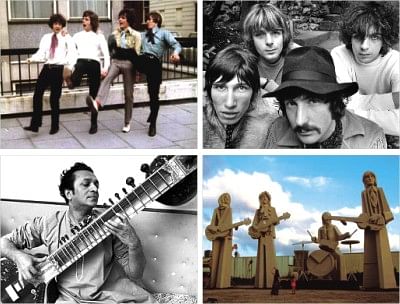
 Often the lyrics of album's were inspired not only by lucid hallucinating dream elements, but also by literary writings on the themes of childhood, nostalgia and the longing to return to innocent. Another great source of inspiration for the artists was the music or ragas of the Indian subcontinent. The use of Sitar and Tambura became popular in psychedelic rock, to the extent that Ravi Shankar, the Indian classical guru was joined by The Beatles. The other major effect of Psychedelia was to be found in the cover arts of various albums. Artists and photographers started to experiment on the artists feature pf albums and many new ground breaking album covers and ideas emerged as a result. The simple covers were replaced by artistic photographs, experimentation with band images, often distorting them. Some bands put the CD's or LP's in unusual covers or put music or light embedded in the cover (Pulse).
Often the lyrics of album's were inspired not only by lucid hallucinating dream elements, but also by literary writings on the themes of childhood, nostalgia and the longing to return to innocent. Another great source of inspiration for the artists was the music or ragas of the Indian subcontinent. The use of Sitar and Tambura became popular in psychedelic rock, to the extent that Ravi Shankar, the Indian classical guru was joined by The Beatles. The other major effect of Psychedelia was to be found in the cover arts of various albums. Artists and photographers started to experiment on the artists feature pf albums and many new ground breaking album covers and ideas emerged as a result. The simple covers were replaced by artistic photographs, experimentation with band images, often distorting them. Some bands put the CD's or LP's in unusual covers or put music or light embedded in the cover (Pulse).
In our country, very few artists have taken an active inspiration from Psychedelic genre. Some of James's tracks maybe considered a mish-mash into the genre mixed with his own heavy influence of bluesy rock. But the underground bands could do much more to look into the possibilities and maybe come up with Bangladesh's first pure psychedelic rock band.
Movie Review


George Clooney brings a slick, ruthless force to the title role of "Michael Clayton," playing a fixer for a powerful law firm. He works in the shadows, cleaning up messes, and he is a realist. He tells clients what they don't want to hear, shooting down their fantasies of "options."
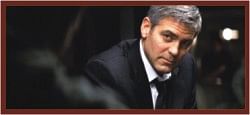 Clayton works directly with Marty Bach (Sydney Pollack), the head of the law firm; it's one of those Pollack performances that embodies authority, masculinity, intelligence and knowing the score. One of Bach's top partners has just gone berserk, stripping naked in Milwaukee during a deposition hearing and running through a parking lot in the snow. This is Arthur Edens (Tom Wilkinson), who opens the film with a desperate voice-over justifying himself to Michael.
Clayton works directly with Marty Bach (Sydney Pollack), the head of the law firm; it's one of those Pollack performances that embodies authority, masculinity, intelligence and knowing the score. One of Bach's top partners has just gone berserk, stripping naked in Milwaukee during a deposition hearing and running through a parking lot in the snow. This is Arthur Edens (Tom Wilkinson), who opens the film with a desperate voice-over justifying himself to Michael.
Amongst those watching the deposition video in horror is Karen Crowder, the chief legal executive for one of Marty Bach's most important clients, a corporation being sued for poisonous pollution. Crowder is played by Tilda Swinton, who has been working a lot lately because of her sheer excellence; she has the same sleek grooming as Clayton, the power wardrobe, every hair in place.
The central reality of the story is that the corporation is guilty, it is being sued for billions, the law firm knows it is guilty, it is being paid millions to run the defense, and now Arthur Edens holds the smoking gun and it's not quite all he's holding when he runs naked through the parking lot.
The legal/business thriller genre has matured in the last 20 years, led by authors like John Grisham and actors like Michael Douglas. It involves high stakes, hidden guilt, desperation to contain information and mighty executives blindsided by gotcha! moments. We're invited to be seduced by the designer offices, the clubs, the cars, the clothes, the drinks, the perfect corporate worlds in which sometimes only the rest room provides a safe haven.
I don't know what vast significance "Michael Clayton" has (it involves deadly pollution but isn't a message movie). But I know it is just about perfect as an exercise in the genre. I've seen it twice, and the second time, knowing everything that would happen, I found it just as fascinating because of how well it was all shown happening. It's not about the destination but the journey, and when the stakes become so high that lives and corporations are on the table, it's spellbinding to watch the Clooney and Swinton characters eye to eye, raising each other, both convinced that the other is bluffing.

By Gokhra

"Gone Baby Gone” is a dour, fairly intriguing mystery based on the fourth book in a series of South Boston-set detective novels by Dennis Lehane, best known for “Mystic River.” Affleck's younger brother, Casey, stars as Patrick Kenzie, who investigates the disappearance of a 4-year-old Dorchester girl. Her addict mother (Amy Ryan) is so obviously unfit for parenting, that the audience's sympathies are mixed, to Lehane's credit, from the outset.
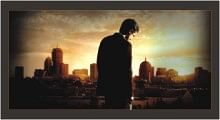 Kenzie's partner and lover is Angie (Michelle Monaghan, on the money), young and tough like Patrick but unprepared for the scuzz they encounter on the search. Inevitably simplifying the book's maze of corruption, the adaptation by director Affleck and Aaron Stockard guides us through the ooze, letting actors such as Ed Harris run like the wind with their scenery-chewing opportunities. He plays Bressant, a detective who may know more than he's telling. Morgan Freeman brings his patented if increasingly unsurprising gravitas to the role of a police captain whose own child was a victim of kidnappers, or worse, and was never found.
Kenzie's partner and lover is Angie (Michelle Monaghan, on the money), young and tough like Patrick but unprepared for the scuzz they encounter on the search. Inevitably simplifying the book's maze of corruption, the adaptation by director Affleck and Aaron Stockard guides us through the ooze, letting actors such as Ed Harris run like the wind with their scenery-chewing opportunities. He plays Bressant, a detective who may know more than he's telling. Morgan Freeman brings his patented if increasingly unsurprising gravitas to the role of a police captain whose own child was a victim of kidnappers, or worse, and was never found.
Affleck knows these streets; as for how to film them, and where the put the camera in relation to the mugs on screen, he's intermittently effective. Lehane's world is full of tricky moral choices that really aren't so tricky in the end; by the time we arrive at the source of the rot, we're handed law-breakers who did “good” deeds, exacting their own vigilante justice. It may be satisfying, but it's also formulaic.
The film is reasonably effective all the same, though Affleck has yet to learn how to conduct each scene like a musical score, paying attention to matters of tempo and dynamics. The film feels longish, and it's not, really.
As for the other Affleck, the gravel-voiced Casey, he is turning into his own sort of good actor. “Gone Baby Gone” finds Affleck and Monaghan working in a relaxed, comfortable vein. They don't push the tougher-than-thou act (although the script gives Affleck one too many easy zingers directed at his crime-solving inferiors). Harris, by contrast, is a reliably superb actor who comes off pretty hammy under Affleck's direction, or lack of it. Sometimes the toughest thing a director can say to an actor“less, please”is also the best thing.

Anime Review By Le Chupacabra
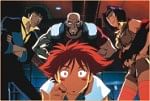 Spike Spiegel and Jet Black are but two of innumerable bounty hunters that make their living catching criminals… for a price, obviously. Man has expanded so extensively into the vast reaches of space that the inception of an equally pervasive organised crime control unit borders on utmost unfeasibility. As a result, the authorities have reinstated the 'bounty' system of the Wild West of old. The days have gone by routinely for the duo until the day they bump into the vivacious vixen named Faye Valentine…
Spike Spiegel and Jet Black are but two of innumerable bounty hunters that make their living catching criminals… for a price, obviously. Man has expanded so extensively into the vast reaches of space that the inception of an equally pervasive organised crime control unit borders on utmost unfeasibility. As a result, the authorities have reinstated the 'bounty' system of the Wild West of old. The days have gone by routinely for the duo until the day they bump into the vivacious vixen named Faye Valentine…
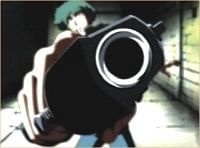 Fortunately for all those who appreciate any form of the animated medium, the real Cowboy Bebop exists as a sophisticated, gritty piece of a noir action-thriller with a great sense of tongue-in-cheek humour.
Fortunately for all those who appreciate any form of the animated medium, the real Cowboy Bebop exists as a sophisticated, gritty piece of a noir action-thriller with a great sense of tongue-in-cheek humour.
With explanations sl owly permeating throughout the series, Bebop does a rather brilliant job of drawing you into the future of humankind. It's not the sparkling utopian or sterile dystopian outlook that one may expect; rather, it's a grimy, believable place that has its fair share of majestic skyscrapers and seedy slums. By portraying the individuals living their lives out as they do, Bebop avoids any unnecessarily loquacious explanations of the whys-and-wherefores of the status quo of the Universe; things are as they are and that's where we begin.
owly permeating throughout the series, Bebop does a rather brilliant job of drawing you into the future of humankind. It's not the sparkling utopian or sterile dystopian outlook that one may expect; rather, it's a grimy, believable place that has its fair share of majestic skyscrapers and seedy slums. By portraying the individuals living their lives out as they do, Bebop avoids any unnecessarily loquacious explanations of the whys-and-wherefores of the status quo of the Universe; things are as they are and that's where we begin.
Despite a few expected back-plot portions here and there, the Bebop crew break through any hint of typecasting with sheer personality and spirit. As such, Cowboy Bebop goes on present one of the most enigmatic, memorable individuals in anime in the form of Spike Spiegel. While his role in the general activities of the Bebop party seems rather transient and detached, his own underlying story is a slick, surreal journey of illusion, free will and unconscious serendipity.
 The art of Bebop is evocative and creates a great sense of contrast with delicate nuances and harsh detail. The animation is gloriously fluid with a myriad of subtle, gritty minutiae that are expected of older works of anime. The fight scenes are some of the best portrayals of such with the use of fantastic choreography, symbolic locales and masterful lighting. The character designs are quite unforgettable and distinct.
The art of Bebop is evocative and creates a great sense of contrast with delicate nuances and harsh detail. The animation is gloriously fluid with a myriad of subtle, gritty minutiae that are expected of older works of anime. The fight scenes are some of the best portrayals of such with the use of fantastic choreography, symbolic locales and masterful lighting. The character designs are quite unforgettable and distinct.
What truly lends Bebop its unique atmosphere is the symphonious music arranged and composed by maestro Yoko Kanno.
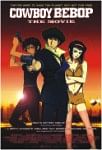 Utilising a rather invigorating accretion of jazz and blues pieces to create a diverse, sumptuous aural experience, this anime stands as one of the pinnacles of sound design. Surprisingly, the anime utilises mostly English singers to lend it the distinctive American flavour already set forth by the atmosphere, visuals and themes.
Utilising a rather invigorating accretion of jazz and blues pieces to create a diverse, sumptuous aural experience, this anime stands as one of the pinnacles of sound design. Surprisingly, the anime utilises mostly English singers to lend it the distinctive American flavour already set forth by the atmosphere, visuals and themes.
Cowboy Bebop is still one of the finest anime out there because it takes everything that's brilliant about it and then offers an engrossing experience that's truly more profound than the sum of its parts. One of the greatest virtues of Bebop is that it's easily one of the most accessible anime out there for most viewers much like FullMetal Alchemist is. While it caters to a slightly mature audience, Bebop is still an unforgettable accomplishment in the realm of animation.
